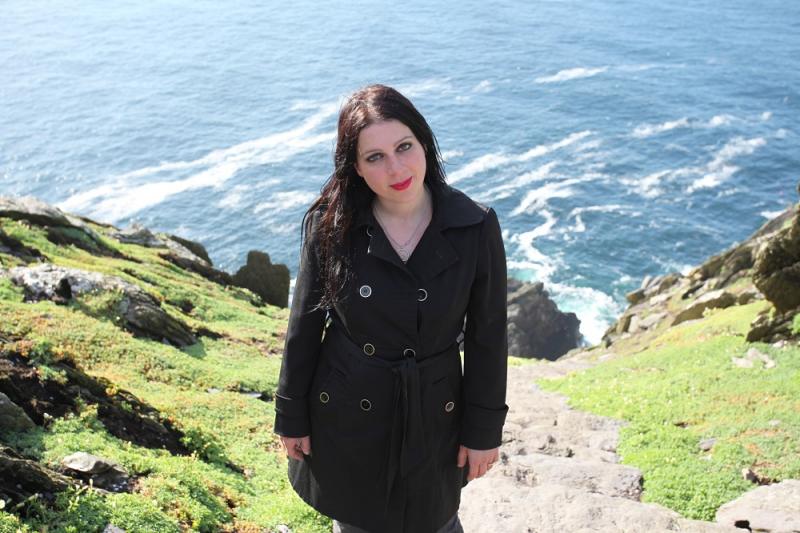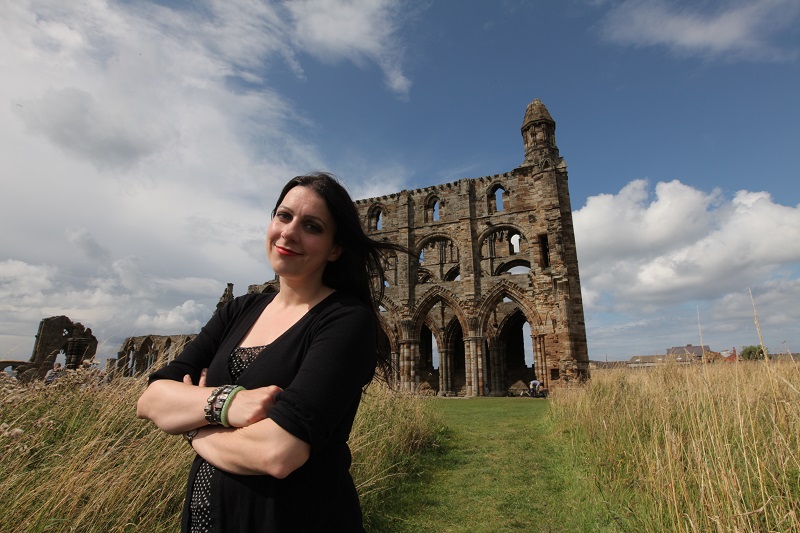Saints and Sinners: Britain's Millennium of Monasteries, BBC Four | reviews, news & interviews
Saints and Sinners: Britain's Millennium of Monasteries, BBC Four
Saints and Sinners: Britain's Millennium of Monasteries, BBC Four
Dr Janina Ramirez throws light on the Dark Ages

When in Hilary Mantel’s Bring Up the Bodies Thomas Cromwell exclaims in exasperation, “to each monk, one bed; to each bed, one monk. Is that so hard for them?” he sums up the state of moral decay into which the monasteries had apparently lapsed by the time of their dissolution.
Much as we tend to think of the monasteries as essentially medieval, the monastic ideal was flourishing in the British Isles a full millennium before Henry VIII and Thomas Cromwell ended the party in the mid-16th century. Before the great Benedictine monasteries there were hermits, whose adherence to a life of deprivation and isolation in the far-flung reaches of Ireland and Scotland was inspired by Christ’s suffering in the desert, where he battled Satan for 40 days and 40 nights. But as hermits inevitably attracted sightseers and followers, they began to form communities of sorts, founded on the principle that “monks came together to be alone”.
Making her way gamely to the extraordinarily inhospitable Skellig St Michael (main picture), not much more than a large rock off the west coast of Ireland, and the site of an ancient and very well preserved collection of monks’ cells, was Dr Janina Ramirez, whose difficult journey, despite a motor boat and fine weather, really emphasised the isolation of the place. Her astonishment at the harshness of the life these hermits must have endured was clear, although archaeologist John Sheehan grimly reminded her that a lifetime would not have been long, with most inhabitants dying in their 20s and 30s.
 Frankly, a lot of these visionaries and zealots would today probably be diagnosed with psychological disorders, something that Ramirez politely sidestepped, and in her quest to find out more about the monkish persona, she went to visit the abbot of Mount St Bernard Abbey in Leicestershire. Now, it must be said that Dr Ramirez is not your average early medieval art historian. This is an area of academe that tends to be characterised by tweed and excess nasal hair, and the overly-curious antiquarians who get into trouble in MR James's ghost stories. Ramirez, in contrast, is, in the nicest possible way, what in Nineties Cambridgeshire we called a greb – or to put it another way, she wouldn’t look at all out of place hanging about Camden Market. She certainly made quite an impression on Father Erik Varden, who probably doesn’t get many chances to chat to women, certainly not one as winsome as Ramirez, and their discussion about the challenges of monastic discipline and Father Erik’s “primary appetites” made slightly uncomfortable viewing.
Frankly, a lot of these visionaries and zealots would today probably be diagnosed with psychological disorders, something that Ramirez politely sidestepped, and in her quest to find out more about the monkish persona, she went to visit the abbot of Mount St Bernard Abbey in Leicestershire. Now, it must be said that Dr Ramirez is not your average early medieval art historian. This is an area of academe that tends to be characterised by tweed and excess nasal hair, and the overly-curious antiquarians who get into trouble in MR James's ghost stories. Ramirez, in contrast, is, in the nicest possible way, what in Nineties Cambridgeshire we called a greb – or to put it another way, she wouldn’t look at all out of place hanging about Camden Market. She certainly made quite an impression on Father Erik Varden, who probably doesn’t get many chances to chat to women, certainly not one as winsome as Ramirez, and their discussion about the challenges of monastic discipline and Father Erik’s “primary appetites” made slightly uncomfortable viewing.
The narrative was well-crafted, and highlighted how, even very early on, monks were only ever just one remove from power. When King Oswald established the Celtic monastery at Lindisfarne in 635AD, British monasticism was set on a trajectory that would bring untold influence and riches, but also ultimately its destruction. At Lindisfarne the monks were, for the first time, no longer concerned solely with securing their own personal salvation but were in the service of secular patrons, safeguarding the souls of the Anglo-Saxon kings. The monks were guardians of knowledge and learning; aside from crumbling buildings and fortifications, Christianity was all that remained of the Roman occupation and the monasteries were the last bastions of civilisation, the Lindisfarne Gospels remaining an astonishing monument to their achievement.
Ramirez’s evocation of Britain as a violent, barbaric place, where the physical remains of the Roman occupation still loomed large, was a compelling backdrop as she described the struggle that took place between the homegrown hermetic tradition and the newer Benedictine monasticism introduced at Canterbury by the Italian monk St Augustine in around the year 600. This European import was based not on solitude but on community, and in its remarkable discipline and organisation it used the Roman army as its template. The ultimate triumph of the Benedictine model was as much a political decision as a spiritual one, Ramirez explaining that “the European union of monasteries would give access to classical knowledge and diplomatic networks.”
As the first buildings to be made of stone since the Romans had left Britain 250 years before, the new Benedictine monasteries must have been truly awe-inspiring. But by reintroducing basilicas with crypts reminiscent of the ancient catacombs of Rome, the Benedictine clerics stilled dissenting voices by conjuring an almost romantic vision of the not so distant past.
rating
Share this article
Add comment
The future of Arts Journalism
You can stop theartsdesk.com closing!
We urgently need financing to survive. Our fundraising drive has thus far raised £33,000 but we need to reach £100,000 or we will be forced to close. Please contribute here: https://gofund.me/c3f6033d
And if you can forward this information to anyone who might assist, we’d be grateful.

Subscribe to theartsdesk.com
Thank you for continuing to read our work on theartsdesk.com. For unlimited access to every article in its entirety, including our archive of more than 15,000 pieces, we're asking for £5 per month or £40 per year. We feel it's a very good deal, and hope you do too.
To take a subscription now simply click here.
And if you're looking for that extra gift for a friend or family member, why not treat them to a theartsdesk.com gift subscription?
more TV
 MobLand, Paramount+ review - more guns, goons and gangsters from Guy Ritchie
High-powered cast impersonates the larcenous Harrigan dynasty
MobLand, Paramount+ review - more guns, goons and gangsters from Guy Ritchie
High-powered cast impersonates the larcenous Harrigan dynasty
 This City is Ours, BBC One review - civil war rocks family cocaine racket
Terrific cast powers Stephen Butchard's Liverpool drug-ring saga
This City is Ours, BBC One review - civil war rocks family cocaine racket
Terrific cast powers Stephen Butchard's Liverpool drug-ring saga
 The Potato Lab, Netflix review - a K-drama with heart and wit
Love among Korean potato-researchers is surprisingly funny and ideal for Janeites
The Potato Lab, Netflix review - a K-drama with heart and wit
Love among Korean potato-researchers is surprisingly funny and ideal for Janeites
 Adolescence, Netflix review - Stephen Graham battles the phantom menace of the internet
How antisocial networks lead to real-life tragedy
Adolescence, Netflix review - Stephen Graham battles the phantom menace of the internet
How antisocial networks lead to real-life tragedy
 Drive to Survive, Season 7, Netflix review - speed, scandal and skulduggery in the pitlane
The F1 documentary series is back on the pace
Drive to Survive, Season 7, Netflix review - speed, scandal and skulduggery in the pitlane
The F1 documentary series is back on the pace
 A Cruel Love: The Ruth Ellis Story, ITV1 review - powerful dramatisation of the 1955 case that shocked the public
Lucy Boynton excels as the last woman to be executed in Britain
A Cruel Love: The Ruth Ellis Story, ITV1 review - powerful dramatisation of the 1955 case that shocked the public
Lucy Boynton excels as the last woman to be executed in Britain
 Towards Zero, BBC One review - more entertaining parlour game than crime thriller
The latest Agatha Christie adaptation is well cast and lavishly done but a tad too sedate
Towards Zero, BBC One review - more entertaining parlour game than crime thriller
The latest Agatha Christie adaptation is well cast and lavishly done but a tad too sedate
 Bergerac, U&Drama review - the Jersey 'tec is born again after 34 years
Damien Molony boldly follows in the hallowed footsteps of John Nettles
Bergerac, U&Drama review - the Jersey 'tec is born again after 34 years
Damien Molony boldly follows in the hallowed footsteps of John Nettles
 A Thousand Blows, Disney+ review - Peaky Blinders comes to Ripper Street?
The prolific Steven Knight takes us back to a squalid Victorian London
A Thousand Blows, Disney+ review - Peaky Blinders comes to Ripper Street?
The prolific Steven Knight takes us back to a squalid Victorian London
 Zero Day, Netflix review - can ex-President Robert De Niro save the Land of the Free?
Panic and paranoia run amok as cyber-hackers wreak havoc
Zero Day, Netflix review - can ex-President Robert De Niro save the Land of the Free?
Panic and paranoia run amok as cyber-hackers wreak havoc
 The White Lotus, Series 3, Sky Atlantic review - hit formula with few surprises but a new bewitching soundtrack
Thailand hosts the latest bout of Mike White's satirical takedown of the rich and privileged
The White Lotus, Series 3, Sky Atlantic review - hit formula with few surprises but a new bewitching soundtrack
Thailand hosts the latest bout of Mike White's satirical takedown of the rich and privileged
 Hacks, Season 3, NOW review - acerbic showbiz comedy keeps up the good work
Jean Smart's portrayal of Deborah Vance is an all-time classic
Hacks, Season 3, NOW review - acerbic showbiz comedy keeps up the good work
Jean Smart's portrayal of Deborah Vance is an all-time classic

Comments
Lots of good stuff here but
Aesthetic /Ascetic ? Yes I
I've watched the series now,
The word she actually uses